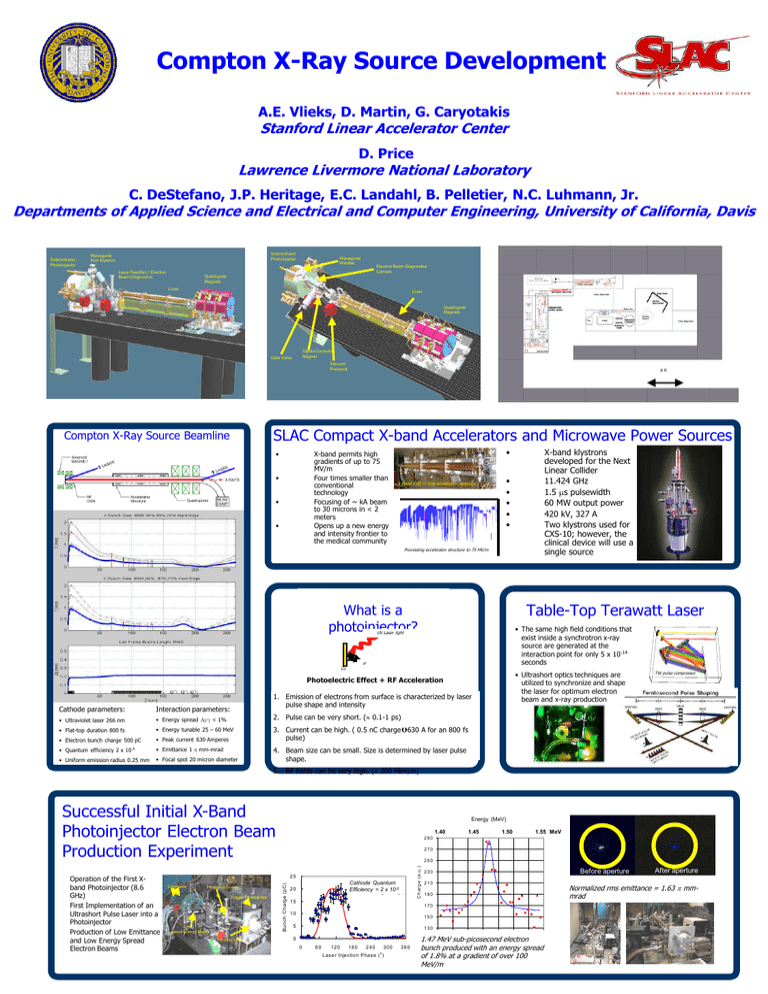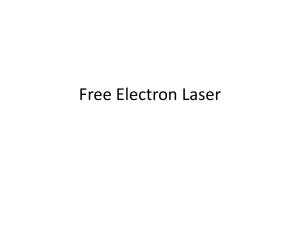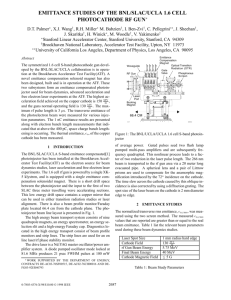Compton X-Ray Source Development
advertisement

Compton X-Ray Source Development A.E. Vlieks, D. Martin, G. Caryotakis Stanford Linear Accelerator Center D. Price Lawrence Livermore National Laboratory C. DeStefano, J.P. Heritage, E.C. Landahl, B. Pelletier, N.C. Luhmann, Jr. Departments of Applied Science and Electrical and Computer Engineering, University of California, Davis Solenoid and Photoinjector Solenoid and Photoinjector Waveguide from Klystron Laser Feedthru / Electron Beam Diagnostics Waveguide Window Electron Beam Diagnostics Camera Quadrupole Magnets Linac Linac Quadrupole Magnets Dipole Corrector Magnet Gate Valve Vacuum Pumpout 6 ft SLAC Compact X-band Accelerators and Microwave Power Sources Compton X-Ray Source Beamline • X-band permits high gradients of up to 75 MV/m Four times smaller than conventional technology Focusing of ~ kA beam to 30 microns in < 2 meters Opens up a new energy and intensity frontier to the medical community • • • • X-band klystrons developed for the Next Linear Collider 11.424 GHz 1.5 ms pulsewidth 60 MW output power 420 kV, 327 A Two klystrons used for CXS-10; however, the clinical device will use a single source • • • • • X-band 1.05 m long accelerator structure Processing accelerator structure to 75 MV/m Before aperture What is a photoinjector? Table-Top Terawatt Laser • The same high field conditions that exist inside a synchrotron x-ray source are generated at the interaction point for only 5 x 10-14 seconds UV Laser light eCu • Ultrashort optics techniques are utilized to synchronize and shape the laser for optimum electron beam and x-ray production Photoelectric Effect + RF Acceleration 1. Emission of electrons from surface is characterized by laser pulse shape and intensity Cathode parameters: Interaction parameters: • Ultraviolet laser 266 nm • Energy spread g/g < 1% • Flat-top duration 800 fs • Energy tunable 25 – 60 MeV • Electron bunch charge 500 pC • Quantum efficiency 2 x 10-5 • Uniform emission radius 0.25 mm TW pulse compressor 2. Pulse can be very short. ( 0.1-1 ps) • Peak current 630 Amperes • Emittance 1 p mm-mrad • Focal spot 20 micron diameter 3. Current can be high. ( 0.5 nC charge630 A for an 800 fs pulse) 4. Beam size can be small. Size is determined by laser pulse shape. 12 fs laser oscillator 5. RF fields can be very high. ( 200 MeV/m) Successful Initial X-Band Photoinjector Electron Beam Production Experiment Trigger Photodiode Laser Energy Meter Faraday Cup 1.55 MeV 250 3 Cathode Quantum 0 q q 0 e xp -5 Efficiency = 2 x10 20 15 C h a rg e (a .u .) Phosphor Screen 1.50 270 25 Solenoids 1.45 290 Bu n c h Ch a rg e (p C) Operation of the First Xband Photoinjector (8.6 GHz) First Implementation of an Ultrashort Pulse Laser into a Photoinjector Production of Low Emittance and Low Energy Spread Electron Beams Energy (MeV) 1.40 Before aperture 230 210 190 170 10 150 5 130 1.47 MeV sub-picosecond electron P ixe l Numbe r bunch produced with an energy spread of 1.8% at a gradient of over 100 MeV/m 850 0 0 60 120 180 240 300 o Laser Injection Phase ( ) 360 After aperture Normalized rms emittance = 1.63 p mmmrad 855 860 865 870 875 880 885 The X-Band Photoinjector: A New Source of High Brightness Electron Beams Electromagnetic Simulations Pre-bonding RF gun with new cell 6 Qext ~ 4900 Pi mode field profile 0.4 T = 22.8 C 1 0.35 string added 0.8 E-field (relative) RF Gun 2D Electric Field Profile from SUPERFISH S11 Magnitude 0.3 0.25 0.2 0.6 11414.6 MHz 0.4 0.15 0.1 0.2 0.05 11.440 11.435 11.430 200 11.425 150 11.420 100 Position in z 11.415 50 11.410 0 11.405 0 0 11.400 11424.3 MHz 3D HFSS modeling to adjust Q ext and frequency Freq GHz Post-bonding 0.35 1 0.3 0.9 0.25 0.8 0.2 0.7 Cold test photoinjector cavity Cold Tests 11.41350 GHz 8.7 MHz 0.15 0.6 0.1 0.5 0.4 0.05 11.4222 GHz 0 0 50 100 150 200 0.3 11.4 11.41 11.41 11.42 11.42 11.43 11.43 11.43 11.44 Bead-pull apparatus for cold testing of field profiles Field flatness maintained and frequency change quantified Emittance Compensation Solenoid Magnet 6 5 4 3 2 1 0 2 4 6 8 12 10 14 16 18 20 Z (cm) Individual Tuning of Final Cells Frequency Sensitivity: F r 29 MHz / mil Waveguide Assembly Components Input waveguide Coax. antenna Ceramic Window Power Splitter Endcaps Cathode Cells 2-5 Beam Exit Cell 1 Pump-out port Cell 6 Structure Bonding Photoinjector cells in bonding furnace Water-cooling Final Mechanical Design and Fabrication Waveguide Assembly Final Bonded Photoinjector Cavity 1. RF Design. 2. Beam dynamics design. 3. Manufacture of cold-test parts. 4. Diffusion bonding of cold-test Injector. 5. Re-measurement of cold-test Injector. 6. Coupler redesign. 7. Manufacture of final Gun parts 8. Cold testing/tuning of final gun parts. 9. Assembly/diffusion bonding 10. High Power tests underway











